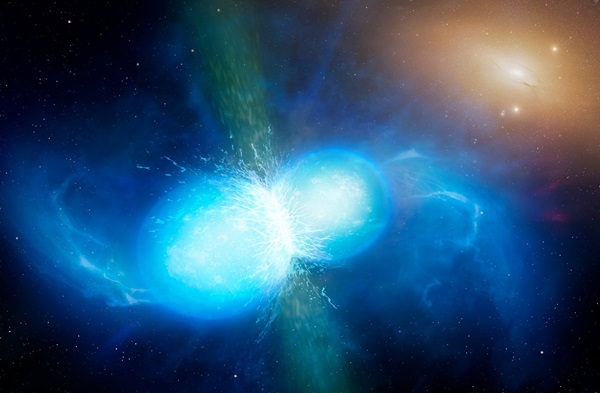Key Takeaways:
If you could freeze a film of two neutron stars crashing into each other, just after they collide, you would witness the formation of an object so massive and dense it shouldn’t exist: The stars would momentarily merge into a single neutron star that is spinning so fast it can briefly hold itself up against collapse, defying gravity like Wile E. Coyote after he’s run off a cliff.
Just a few frames later, however, and the star would be gone, sucked into itself and replaced by a black hole.
Unfortunately, astronomers have limited ways to study such objects, called hypermassive neutron stars (HMNSs). That’s because although neutron stars emit gravitational waves — ripples in the fabric of space-time — as they spiral in toward each other, current detectors are not sensitive to the frequencies emitted by the HMNS itself.
But now, astronomers may have found another path to understanding hypermassive neutron stars.
According to a new paper, some HMNSs emit characteristic short bursts of gamma-rays during their death throes. And when researchers led by Cecilia Chirenti of the University of Maryland in College Park analyzed 700 short gamma-ray bursts (GRBs), they found a few cases where the signals were not purely noise.
Instead, these GRBs had characteristic frequencies that were stronger than others, a signature “consistent with a hypermassive neutron star,” Chirenti said at a Jan. 9 press conference during the 241st meeting of the American Astronomical Society in Seattle.
The new study, published Jan. 9 in Nature, gives astronomers hope that they may be able to learn more about hypermassive neutron stars, which are the fastest-rotating stars known, as well as learn more about the dynamics of neutron star mergers in general.
“There is no escape”
Neutron stars are the densest objects that can exist, short of black holes. They are the remnants of stars so massive that they explode at the end of their lives as supernovae, but not so massive that they immediately collapse into black holes.
Given that most of the stars in the universe are in binary or multiple star systems, not infrequently, a pair of binary stars can both end their lives as neutron stars. And over time, they may spiral in toward each other and collide.
When these catastrophic collisions occur, they blast out gamma-rays that can be detected by telescopes after traveling for billions of years. The stellar mashups also produce gravitational waves, some of which can be detected by facilities like the Laser Interferometer Gravitational-wave Observatory (LIGO) in the U.S. and Virgo in Europe. Based on these observations, scientists currently think that if the resulting neutron star is more massive than roughly 2.2 times that the Sun, it will collapse into a black hole.
If it is not too massive, then a hypermassive neutron star can survive — but only for a split-second.
“There is no escape,” said Chirenti. “It just hangs in there for this brief time because it is spinning just so fast.” (Astronomers have seen one that survived for nearly a day, but that one is exceptional.)
Shedding light on hypermassive neutron stars
To try to glean more information about these short-lived stars, Chirenti and her team noted that computer models predict the gamma-ray brightness of a HMNS may flicker a few thousand times per second. So, by determining the precise rate of this flickering, astronomers could potentially gain insight into the size and spin rate of the HMNS. But to date, no such gamma-ray oscillations had been identified.
NASA’s Goddard Space Flight Center and STAG Research Centre/Peter Hammond
So, Chirenti and her colleagues scoured archival data from three NASA space-based gamma-ray observatories: the Fermi Gamma-Ray Space Telescope and the Neil Gehrels Swift Observatory (both operational today), as well as the Compton Gamma Ray Observatory.
Because a HMNS is still “shaking and jiggling,” as Chirenti put it, a hypermassive neutron star produces quasi-periodic oscillations (QPOs). This means that, instead of uniformly flickering at a single frequency, there are a wash of frequencies centered around peak frequencies.
Chirenti compares it to listening to a tuning fork emit a single clean frequency versus hearing an orchestra tune its instruments before a concert: Not everything is totally in tune, but you can still make out some tones that are stronger than others.
Out of the more than 700 events analyzed, the team found QPOs in two of them, designated GRB 910711 and GRB 931101B. Both of these were detected by Compton, which NASA operated during the 1990s and deorbited in 2000. Despite Compton’s age, for this study, it “was an amazing instrument because of its large detector area and great timing capabilities,” Chirenti said.
Their analysis found the strongest oscillations were at a frequency of roughly 2,600 times per second. According to simulations, this suggests that the HMNS responsible is spinning at least 1,300 times per second.
However, that spin rate is only a lower limit: Just like light is redshifted by the expansion of the universe, the frequency of the quasi-periodic oscillation may have been higher originally. But even if it were very nearby, the HMNS would still be spinning nearly twice as fast as the fastest known pulsar, a class of rapidly spinning neutron stars.
“These results are very important, as they set the stage for future measurements of hypermassive neutron stars by gravitational wave observatories,” Chryssa Kouveliotou, chair of the physics department at George Washington University in Washington, who was not involved in the study, said in a NASA news release.
Chirenti hopes that by the 2030s, more advanced gravitational-wave detectors will be capable of studying the space-time ripples produced by hypermassive neutron stars.
“In the meantime,” says Chirenti, “we’ll keep looking for them in gamma rays.”










